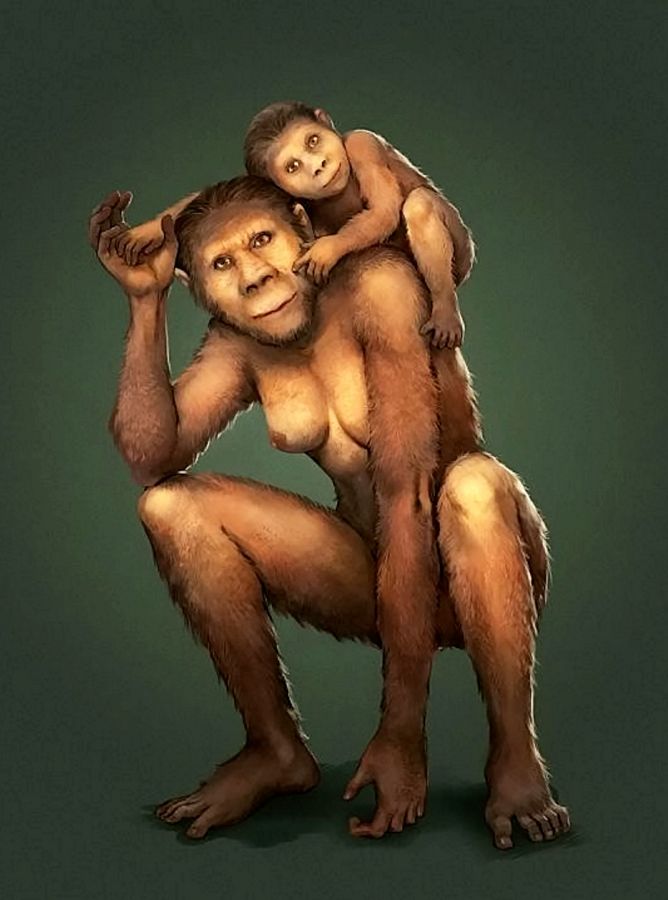An early human ancestor that lived in Africa millions years ago was breastfed until 12-months-old, according to a new study.
Scientists say that the discovery show the maternal behaviour of Australopithecus africanus was closer to modern humans than great apes – which nurse for longer.
The findings were based on a chemical analysis of five fossilised teeth from two individuals that lived in Africa between 2.1 and 2.6 million years ago.
Infants were suckled continuously during the first year of life – and then only sporadically to boost their diet owing to food shortages and seasonal changes.
Lead author Dr Joannes-Boyau, a geochemist at Southern Cross University in Australia, said: “For the first time, we gained new insight into the way our ancestors raised their young, and how mothers had to supplement solid food intake with breastmilk when resources were scarce.”
The study, published in the journal Nature, sheds fresh light on the history of human evolution. A. africanus, meaning southern ape of Africa, is a direct ancestor.
Now its motherly instincts and extended parental care, considered a hallmark of Homo sapiens, have been unearthed for the first time.
Co author Dr Luca Fiorenza, an expert in the evolution of the human diet at Monash University in Melbourne, said: “These finds suggest for the first time the existence of a long-lasting mother-infant bond in Australopithecus.
“This makes us to rethink on the social organisations among our earliest ancestors.”
The teeth were dug up in the Sterkfontein caves in South Africa’s Gauteng province. Traces of the mineral barium revealed how long they had been breastfed for.
Co author Dr Justin Adams, a palaeoecologist at Monash, said: “Fundamentally, our discovery of a reliance by Australopithecus africanus mothers to provide nutritional supplementation for their offspring and use of fallback resources highlights the survival challenges that populations of early human ancestors faced in the past environments of South Africa.”
For decades there has been speculation about how early ancestors raised their offspring. The teeth open up a window into this key development by acting as a ‘time capsule’.
A. africanus lived from about two to three million years ago during a period of major climatic and ecological change in South Africa.
The slender and agile species was characterised by a combination of human and ape-like traits. Its first fossils were found almost a century ago.
Using state of the art laser techniques, the researchers vaporised microscopic portions on the surface of the tooth to finally unlock the secrets of how they raised their young,
Teeth grow similarly to trees. They form by adding layer after layer of enamel and dentine tissues every day.
Thus, teeth are particularly valuable for reconstructing the biological events occurring during the early period of life of an individual.
They preserve precise temporal changes and chemical records of key elements incorporated in the food we eat.
By developing micro geochemical maps, we are able to ‘read’ successive bands of daily signal in teeth, which provide insights into food consumption and stages of life.
Previously the team had revealed the nursing behaviour of our closest evolutionary relatives, the Neanderthals.
With this latest study, the international team has analysed teeth that are more than ten times older than those.
Dr Joannes-Boyau said: “We can tell from the repetitive bands that appear as the tooth developed that the fall back food was high in lithium, which is believed to be a mechanism to reduce protein deficiency in infants more prone to adverse effect during growth periods.

“This likely reduced the potential number of offspring, because of the length of time infants relied on a supply of breastmilk.
“The strong bond between mothers and offspring for a number of years has implications for group dynamics, the social structure of the species, relationships between mother and infant and the priority that had to be placed on maintaining access to reliable food supplies.”
A. africanus had human-like heads and large brains and long ape like arms and a prominent jaw. It ate fruits, grasses, leaves and roots.
Dr Adams said: “This finding underscores the diversity, variability and flexibility in habitats and adaptive strategies these australopiths used to obtain food, avoid predators, and raise their offspring.”
At the time southern Africa had wet summers and dry winters – providing an abundance and dearth of food, respectively.
Evidence of this was backed by the teeth which showed regular cycles of increasing and decreasing barium.
Dr Fiorenza added: “This is the first direct proof of maternal roles of one of our earliest ancestors and contributes to our understanding of the history of family dynamics and childhood.”
The team says it will now work on species that have evolved since, to develop the first comprehensive record of how infants were raised throughout history.

